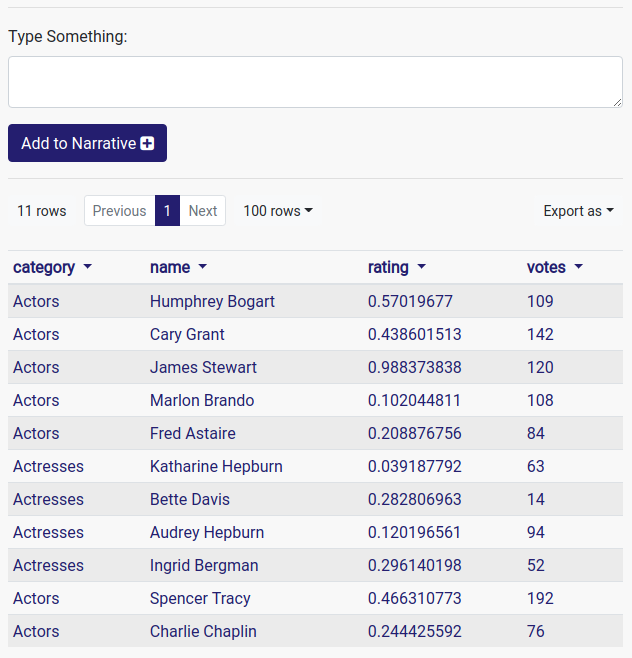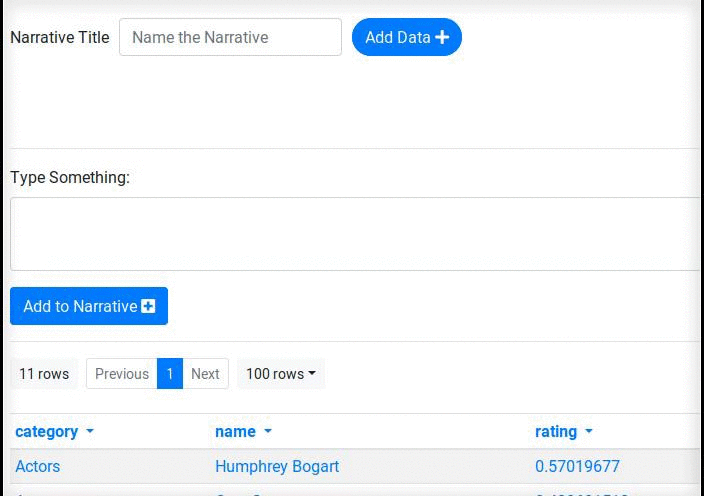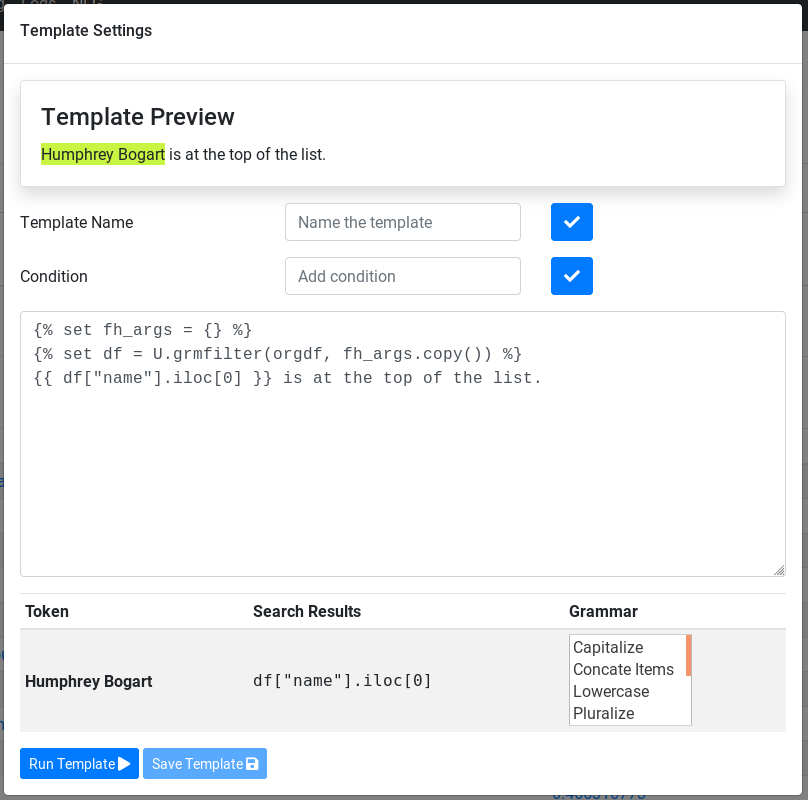Natural Language Generation component for Gramex. The NLG module is designed to work as a Python library, as well as a Gramex application.
The library:
- Automatically creates tornado templates from English text in the context of a dataset.
- Allows for modification and generalization of these templates.
- Renders these templates as a unified narrative.
The NLG library can be installed from PyPI as follows:
$ pip install nlg
$ python -m spacy download en_core_web_sm
$ gramex setup uior from source as follows:
$ git clone https://github.com/gramener/gramex-nlg.git
$ cd gramex-nlg
$ pip install -e .
$ gramex setup ./appTo get started, see the example notebook here.
>>> import pandas as pd
>>> from gramex import data
>>> # load some data
>>> df = pd.read_csv('iris.csv')
>>> # specify a FormHandler operation - find the average sepal_width per species
>>> fh_args = {'_by': ['species'], '_c': ['sepal_width|avg'], '_sort': ['sepal_width|avg']}
>>> # Draw a sample
>>> xdf = df.sample(frac=0.1, random_state=10)
>>> # perform the FormHandler operation on the data
>>> print(data.filter(xdf, fh_args.copy()))
species sepal_width|avg
2 virginica 2.70
1 versicolor 2.92
0 setosa 3.15
>>> # Write something about the output
>>> from nlg.utils import load_spacy_model
>>> text = nlp("The virginica species has the least average sepal_width.")
>>> # Generate a template
>>> from nlg.search import templatize
>>> tmpl = templatize(text, fh_args, xdf)
>>> print(tmpl)
{% set fh_args = {"_by": ["species"], "_c": ["sepal_width|avg"], "_sort": ["sepal_width|avg"]} %}
{% set df = U.gfilter(orgdf, fh_args.copy()) %}
{% set fh_args = U.sanitize_fh_args(fh_args, orgdf) %}
The {{ df["species"].iloc[0] }} species has the least average {{ fh_args["_sort"][0].lower() }}.
>>> # Render the same template with new data.
>>> print(render(df, tmpl).decode('utf8'))
The versicolor species has the least average sepal_width|avg.The NLG module ships with an IDE. The IDE is a Gramex application.
To use it, install the NLG module as indicated above, and add the
following to your gramex.yaml:
variables:
NLG_ROOT:
function: nlg.utils._locate_app_config()
import:
nlg:
path: $NLG_ROOT
YAMLURL: $YAMLURL/nlgThis configuration mounts the app at the /nlg/ resource. Start gramex to access it.
The NLG component depends on two sources of information:
- A source dataset, which can be uploaded on to the IDE. A dataset is uniquely identified with its filename. Once uploaded, the file persists and is available for selection from the app. Any file that makes a valid URL for FormHandler can be used with the NLG app.
- A narrative, which is a collection of templates and rules around them. The narrative consists of the configuration which governs the rendered text. An existing narrative can be uploaded through the "Add Data" button, or can be created through the IDE. Once created, the narrative can be named and becomes available for selection from the "Add Data" modal.
The primary purpose of the IDE is to create or edit narratives based on a dataset. Once a dataset has been selected, it is exposed in the IDE as a FormHandler table.
Users can now type English text into the IDE and add it to the narrative. This automatically templatizes the text, and adds the template to the narrative. For example, typing "Humphrey Bogart is at the top of the list." does this:
This means that the input statement has been templatized and added to the narrative. The part of the input text that was successfully templatized is highlighted in green. Clicking on the spanner button next to a template opens the Template Settings modal.
This dialog provides configuration options for all template attributes:
- Template Name - Each template can optionally be named.
- Condition - Any Python expression which evaluates to a boolean may be set as a condition, which controls whether the template is rendered.
- The actual Tornado template itself can be edited. Any valid Tornado template is acceptable.
- Token Settings - Every token from the input text that finds a
match in the dataset or in FormHandler arguments (i.e. every token
that is highlighted in the preview) is converted into a template
expression.
Such tokens have their own attributes, as follows:
- Token search results - if a token is found in more than one place (say, a dataframe cell as well as a FormHandler argument), this setting allows the user to select the right result.
- Grammar options - the NLG engine may automatically apply certain string formatting or lexical operations to the template expression to make it match the input text. Any number of these operations can be enabled / disabled through this setting.
- Make variable - a token may be set as a local variable within the template.
- Ignore - the template expression corresponding to the token may be ignored, and set back to the literal input text.
- Run Template - Run the current template against the dataframe and preview its output.
- Save Template - Save the template. Note that this is required if the template has been manually edited in the textarea.
Once a narrative has been fully configured, it can be named and saved. Doing so causes it to appear the narrative dropdown menu on the app.
After a narrative has been named and saved, it be shared in two modes:
- IDE mode - This option lets users copy a URL that redirects to the IDE, with the current dataset and the current narrative set in the session.
- Embed mode - Copy an HTML snippet to embed into a page which contains a Formhandler table. The template will render live as the table changes.
This section describes the building blocks of Gramex's approach to natural language generation. These concepts serve as primitives to the logic and automation capabilities of the NLG engine.
Narrative - A narrative is a piece of text written by a user or generated by a machine which contains facts about a dataset. A narrative in its entirity is assumed to be a function of three items:
- A dataset
- Operations on that dataset
- Some "source text" provided by the user.
For example, the following is a narrative about the Fisher Iris dataset.
The iris dataset contains measurements from a hundred and fifty samples of three unique species of the iris flower - setosa, versicolor and virginica. The species are equally distributed within the dataset, so that each species has fifty samples. For each sample, four measurements are taken - sepal width, petal width, sepal width and sepal length. The average petal length of the setosa is significantly less than that of versicolor or virginica. The average petal width of virginica is much higher than that of versicolor. However, there is no pair of features that can uniquely identify a species. The presence of such properties makes the iris dataset ideal for explaining machine learning concepts.
Nugget - A nugget is ideally a single sentence which conveys a fact about the data. Each sentence in the example narrative except the last two is a nugget. Note that each nugget derives its facts from the source data directly, or from the result of some operation on the data. For example, the following nugget
The average petal length of the setosa is significantly less than that of versicolor or virginica.
derives from a groupby-and-average operation on one column of the dataset. Some nuggets, like the one enumerating the number of samples in the dataset, derive from the raw dataset, not from the result of any operations on it. A narrative is essentially an ordered collection of nuggets.
Variables - A variable is a piece of text which can change with the data or the operations performed on it. Here is a reproduction of the example narrative, with all variables shown in bold.
The iris dataset contains measurements from a hundred and fifty samples of three unique species of the iris flower - setosa, versicolor and virginica. The species are equally distributed within the dataset, so that each species has fifty samples. For each sample, four measurements are taken - sepal width, petal width, sepal width and sepal length. The average petal length of the setosa is significantly less than that of versicolor or virginica. The average petal width of virginica is much higher than that of versicolor. However, there is no pair of features that can uniquely identify a species. The presence of such properties makes the iris dataset ideal for explaining machine learning concepts.
Note that each variable has two defining components:
- a source text, as initially provided by the user
- one or more formulae, which compute the value of the variable for a specific instance of the data. Note that the source text of a variable may be found in multiple places within a dataset, and as such, a variable may have multiple formulae - one of which will have to be preferred by the user.
For example, for the first variable in example narrative, "hundred and fifty" is the source text, and the formula is any machine code that counts the number of rows in the dataset and translates it into a human-readable form. A variable may additionally have other attributes, like:
- a set of linguistic inflections which determine the form of the rendered variable text - these are distinct from the formula itself, in that the formula creates the base form of the text and inflections modify the base form.
- a name used to identify the variable within the template of the nugget
Thus, narratives are composed from nuggets, and nuggets from variables. This grammar allows the NLG engine to approach the problem of data-driven, machine-generated narratives in a more compositional manner than a generative one.


